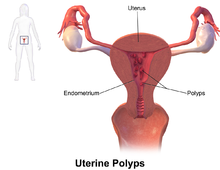| Endometrial polyp | |
|---|---|
| Other names | Uterine polyp |
 | |
| Endometrial polyp, viewed by sonography | |
| Specialty | Gynecology |
An endometrial polyp or uterine polyp is a mass in the inner lining of the uterus. They may have a large flat base (sessile) or be attached to the uterus by an elongated pedicle (pedunculated). Pedunculated polyps are more common than sessile ones. They range in size from a few millimeters to several centimeters. If pedunculated, they can protrude through the cervix into the vagina. Small blood vessels may be present, particularly in large polyps.
Signs and symptoms

They often cause no symptoms. Where they occur, symptoms include irregular menstrual bleeding, bleeding between menstrual periods, excessively heavy menstrual bleeding (menorrhagia), and vaginal bleeding after menopause. Bleeding from the blood vessels of the polyp contributes to an increase of blood loss during menstruation and blood "spotting" between menstrual periods, or after menopause. If the polyp protrudes through the cervix into the vagina, pain (dysmenorrhea) may result.
Cause
No definitive cause of endometrial polyps is known, but they appear to be affected by hormone levels and grow in response to circulating estrogen. Risk factors include obesity, high blood pressure and a history of cervical polyps. Taking tamoxifen or hormone replacement therapy can also increase the risk of uterine polyps. The use of an intrauterine system containing levonorgestrel in women taking tamoxifen may reduce the incidence of polyps.
Diagnosis


Endometrial polyps can be detected by vaginal ultrasound (sonohysterography), hysteroscopy and dilation and curettage. Detection by ultrasonography can be difficult, particularly when there is endometrial hyperplasia (excessive thickening of the endometrium). Larger polyps may be missed by curettage.
Endometrial polyps can be solitary or occur with others. They are round or oval and measure between a few millimeters and several centimeters in diameter. They are usually the same red/brown color of the surrounding endometrium although large ones can appear to be a darker red. The polyps consist of dense, fibrous tissue (stroma), blood vessels and glandlike spaces lined with endometrial epithelium. If they are pedunculated, they are attached by a thin stalk (pedicle). If they are sessile, they are connected by a flat base to the uterine wall. Pedunculated polyps are more common than sessile ones.
Treatment
Polyps can be surgically removed using curettage with or without hysteroscopy. When curettage is performed without hysteroscopy, polyps may be missed. To reduce this risk, the uterus can be first explored using grasping forceps at the beginning of the curettage procedure. Hysteroscopy involves visualising the endometrium (inner lining of the uterus) and polyp with a camera inserted through the cervix. Large polyps can be cut into sections before each section is removed. The presence of cancerous cells may suggest a hysterectomy (surgical removal of the uterus). A hysterectomy is usually not considered when cancer is not present. In either procedure, general anesthetic is typically supplied.
The effects of polyp removal on fertility has not been studied.
Prognosis
Endometrial polyps are usually benign although some may be precancerous or cancerous. About 0.5% of endometrial polyps contain adenocarcinoma cells. Polyps can increase the risk of miscarriage in women undergoing IVF treatment. If they develop near the fallopian tubes, they may lead to difficulty in becoming pregnant. Although treatments such as hysteroscopy usually cure the polyp concerned, recurrence of endometrial polyps is frequent. Untreated, small polyps may regress on their own.
Epidemiology
Endometrial polyps usually occur in women in their 40s and 50s. Endometrial polyps occur in up to 10% of women. It is estimated that they are present in 25% of women with abnormal vaginal bleeding.
See also
References
- WHO Classification of Tumours Editorial Board, ed. (2020). "6. Tumours of the uterine corpus: Endometrial polyp". Female genital tumours: WHO Classification of Tumours. Vol. 4 (5th ed.). Lyon (France): International Agency for Research on Cancer. p. 268. ISBN 978-92-832-4504-9.
- ^ Jane A. Bates (1997). Practical Gynaecological Ultrasound. Cambridge, UK: Cambridge University Press. ISBN 1-900151-51-0.
- ^ "Uterine polyps". MayoClinic.com. 2006-04-27.
- ^ Sternberg, Stephen S.; Stacey E. Mills; Darryl Carter (2004). Sternberg's Diagnostic Surgical Pathology. Lippincott Williams & Wilkins. p. 2460. ISBN 0-7817-4051-7.
- ^ Dysmenorrhea: Menstrual abnormalities at The Merck Manual of Diagnosis and Therapy Professional Edition
- "Endometrial Polyp". GPnotebook. Retrieved 2007-10-20.
- ^ DeCherney, Alan H.; Lauren Nathan (2003). Current Obstetric & Gynecologic Diagnosis & Treatment. McGraw-Hill Professional. p. 703. ISBN 0-8385-1401-4.
- ^ Edmonds, D. Keith; Sir John Dewhurst (2006). Dewhurst's Textbook of Obstetrics and Gynaecology. Blackwell Publishing. p. 637. ISBN 1-4051-5667-8.
- Chan SS, Tam WH, Yeo W, et al. (2007). "A randomised controlled trial of prophylactic levonorgestrel intrauterine system in tamoxifen-treated women". BJOG. 114 (12): 1510–5. doi:10.1111/j.1471-0528.2007.01545.x. PMID 17995495. S2CID 21145823.
- ^ Macnair, Trisha. "Ask the doctor – Uterine polyps". BBC Health. Retrieved 2007-10-21.
- ^ Bajo Arenas, José M.; Asim Kurjak (2005). Donald School Textbook Of Transvaginal Sonography. Taylor & Francis. p. 502. ISBN 1-84214-331-X.
- "Uterine bleeding – Signs and Symptoms". UCSF Medical Center. 2007-05-08. Archived from the original on 2008-04-11. Retrieved 2007-10-20.
- Jayaprakasan, K; Polanski, L; Sahu, B; Thornton, JG; Raine-Fenning, N (Aug 30, 2014). "Surgical intervention versus expectant management for endometrial polyps in subfertile women" (PDF). The Cochrane Database of Systematic Reviews. 8 (8): CD009592. doi:10.1002/14651858.CD009592.pub2. PMC 6544777. PMID 25172985. Archived from the original (PDF) on November 4, 2018. Retrieved November 4, 2018.
- Rubin, Raphael; David S Strayer (2007). Rubin's Pathology: Clinicopathologic Foundations of Medicine. Lippincott Williams & Wilkins. p. 806. ISBN 978-0-7817-9516-6.
{{cite book}}: CS1 maint: location missing publisher (link) - Kaunitz, Andrew M. (2002-08-26). "Asymptomatic Endometrial Polyps: What Is the Likelihood of Cancer?". Medscape Ob/Gyn & Women's Health. Retrieved 2008-04-20.
External links
| Classification | D |
|---|
| Female diseases of the pelvis and genitals | |||||||||||||||||||||||||||||||||||||
|---|---|---|---|---|---|---|---|---|---|---|---|---|---|---|---|---|---|---|---|---|---|---|---|---|---|---|---|---|---|---|---|---|---|---|---|---|---|
| Internal |
| ||||||||||||||||||||||||||||||||||||
| External |
| ||||||||||||||||||||||||||||||||||||